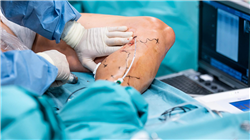University certificate
The world's largest faculty of medicine”
Introduction to the Program
With this 100% online Postgraduate diploma, you will develop advanced technical skills to perform Vascular Interventional Procedures such as Laser Ablation”

According to data from the World Health Organization and the International Society for Vascular Surgery, Vascular Interventional Procedures has experienced an increase in its application due to the increase of chronic vascular diseases worldwide. In response to this situation, emerging technological tools have emerged that allow medical professionals to improve the accuracy, efficacy and safety of clinical procedures. For example, vascular endoscopy is of great benefit for visualizing the interior of blood vessels and performing minimally invasive interventions. Faced with this, physicians need to incorporate advanced strategies into their range of procedures to improve the results in the approach to vascular pathologies.
Within this framework, TECH has developed an innovative Postgraduate diploma in Vascular Interventional Procedures. The academic itinerary will delve into sophisticated methods such as Balloon Angioplasty, the placement of Stent-Grafts or Vasodilator Drugs. At the same time, the syllabus will highlight the importance of imaging for the evaluation, diagnosis and follow-up of Extremity Veins. Along these same lines, the academic materials will cover issues such as Rehabilitation and Prevention of Interventional Complications in Chronic Venous Valve Insufficiency. Thanks to this, the graduates will master a variety of venous treatment techniques and perform interventional procedures effectively.
To consolidate all these contents, TECH is based on the exclusive Relearning methodology. Through this learning system, specialists will reinforce understanding by repeating key concepts throughout the program, which will be presented in various audiovisual media for a progressive and effective acquisition of knowledge. In this sense, the only thing doctors will need is to have a device with
Internet access to enter the Virtual Campus and enjoy the most complete didactic materials in the educational market.
You will access the didactic contents from any device with an Internet connection, even from your cell phone!”
This Postgraduate diploma in Vascular Interventional Procedures contains the most complete and up-to-date scientific program on the market. The most important features include:
- The development of case studies presented by experts in Angiology and Vascular Surgery
- The graphic, schematic, and practical content with which they are created, provide scientific and practical information on the disciplines that are essential for professional practice
- Practical exercises where the self-assessment process can be carried out to improve learning
- Its special emphasis on innovative methodologies
- Theoretical lessons, questions to the expert, debate forums on controversial topics, and individual reflection assignments
- Content that is accessible from any fixed or portable device with an Internet connection
You will delve into how Artificial Intelligence Algorithms are used to analyze vascular images in venous pathology of the lower extremities”
The program’s teaching staff includes professionals from the sector who contribute their work experience to this specializing program, as well as renowned specialists from leading societies and prestigious universities.
The multimedia content, developed with the latest educational technology, will provide the professional with situated and contextual learning, i.e., a simulated environment that will provide immersive education programmed to learn in real situations.
This program is designed around Problem-Based Learning, whereby the professional must try to solve the different professional practice situations that arise during the course. For this purpose, students will be assisted by an innovative interactive video system created by renowned and experienced experts.
Are you looking to master the technique of Balloon Angioplasty? Achieve it in only 540 hours thanks to this revolutionary university program"

A syllabus with a Relearning system that will facilitate the renewal of knowledge in the therapeutic approach to patients with Thoracic Operculum Syndrome"
Why study at TECH?
TECH is the world’s largest online university. With an impressive catalog of more than 14,000 university programs available in 11 languages, it is positioned as a leader in employability, with a 99% job placement rate. In addition, it relies on an enormous faculty of more than 6,000 professors of the highest international renown.

Study at the world's largest online university and guarantee your professional success. The future starts at TECH”
The world’s best online university according to FORBES
The prestigious Forbes magazine, specialized in business and finance, has highlighted TECH as “the world's best online university” This is what they have recently stated in an article in their digital edition in which they echo the success story of this institution, “thanks to the academic offer it provides, the selection of its teaching staff, and an innovative learning method aimed at educating the professionals of the future”
A revolutionary study method, a cutting-edge faculty and a practical focus: the key to TECH's success.
The most complete study plans on the university scene
TECH offers the most complete study plans on the university scene, with syllabuses that cover fundamental concepts and, at the same time, the main scientific advances in their specific scientific areas. In addition, these programs are continuously being updated to guarantee students the academic vanguard and the most in-demand professional skills. In this way, the university's qualifications provide its graduates with a significant advantage to propel their careers to success.
TECH offers the most comprehensive and intensive study plans on the current university scene.
A world-class teaching staff
TECH's teaching staff is made up of more than 6,000 professors with the highest international recognition. Professors, researchers and top executives of multinational companies, including Isaiah Covington, performance coach of the Boston Celtics; Magda Romanska, principal investigator at Harvard MetaLAB; Ignacio Wistumba, chairman of the department of translational molecular pathology at MD Anderson Cancer Center; and D.W. Pine, creative director of TIME magazine, among others.
Internationally renowned experts, specialized in different branches of Health, Technology, Communication and Business, form part of the TECH faculty.
A unique learning method
TECH is the first university to use Relearning in all its programs. It is the best online learning methodology, accredited with international teaching quality certifications, provided by prestigious educational agencies. In addition, this disruptive educational model is complemented with the “Case Method”, thereby setting up a unique online teaching strategy. Innovative teaching resources are also implemented, including detailed videos, infographics and interactive summaries.
TECH combines Relearning and the Case Method in all its university programs to guarantee excellent theoretical and practical learning, studying whenever and wherever you want.
The world's largest online university
TECH is the world’s largest online university. We are the largest educational institution, with the best and widest online educational catalog, one hundred percent online and covering the vast majority of areas of knowledge. We offer a large selection of our own degrees and accredited online undergraduate and postgraduate degrees. In total, more than 14,000 university degrees, in eleven different languages, make us the largest educational largest in the world.
TECH has the world's most extensive catalog of academic and official programs, available in more than 11 languages.
Google Premier Partner
The American technology giant has awarded TECH the Google Google Premier Partner badge. This award, which is only available to 3% of the world's companies, highlights the efficient, flexible and tailored experience that this university provides to students. The recognition as a Google Premier Partner not only accredits the maximum rigor, performance and investment in TECH's digital infrastructures, but also places this university as one of the world's leading technology companies.
Google has positioned TECH in the top 3% of the world's most important technology companies by awarding it its Google Premier Partner badge.
The official online university of the NBA
TECH is the official online university of the NBA. Thanks to our agreement with the biggest league in basketball, we offer our students exclusive university programs, as well as a wide variety of educational resources focused on the business of the league and other areas of the sports industry. Each program is made up of a uniquely designed syllabus and features exceptional guest hosts: professionals with a distinguished sports background who will offer their expertise on the most relevant topics.
TECH has been selected by the NBA, the world's top basketball league, as its official online university.
The top-rated university by its students
Students have positioned TECH as the world's top-rated university on the main review websites, with a highest rating of 4.9 out of 5, obtained from more than 1,000 reviews. These results consolidate TECH as the benchmark university institution at an international level, reflecting the excellence and positive impact of its educational model.” reflecting the excellence and positive impact of its educational model.”
TECH is the world’s top-rated university by its students.
Leaders in employability
TECH has managed to become the leading university in employability. 99% of its students obtain jobs in the academic field they have studied, within one year of completing any of the university's programs. A similar number achieve immediate career enhancement. All this thanks to a study methodology that bases its effectiveness on the acquisition of practical skills, which are absolutely necessary for professional development.
99% of TECH graduates find a job within a year of completing their studies.
Postgraduate Diploma in Vascular Interventional Procedures
The Postgraduate Diploma in Vascular Interventional Procedures created by TECH Global University is a program of high academic quality, designed for health professionals who wish to acquire advanced knowledge in the diagnosis and treatment of venous disorders through vascular interventional techniques. This course, taught in 100% online mode, offers comprehensive and flexible training that allows you to study from anywhere and on your own schedule, while maintaining a high level of interaction and guidance from experts in the field. During this program, you will explore the fundamental aspects of venous interventionism, including the study of vascular anatomy and physiology, diagnostic imaging, venous catheterization techniques, treatment of venous malformations and management of associated complications. One of the most outstanding advantages of this program is the flexibility it offers to study at your own pace and adapt to your work and personal schedules. Through an interactive platform, you will have access to teaching materials, virtual classes, analysis of clinical cases, discussion forums and practical activities, all under the supervision of professionals with extensive experience in vascular interventionism.
Specialize in Vascular Interventional Procedures
This Postgraduate Diploma, developed jointly by specialists in the field, will familiarize you with the use of virtual simulators and simulation tools for specialization in venous catheterization techniques, allowing you to develop practical skills and improve your proficiency in interventional procedures. Upon completion, you will be prepared to apply your knowledge and skills in clinical practice, contributing to the effective diagnosis and treatment of patients with venous disorders. This specialized course will provide you with a competitive advantage in the field of Vascular Interventional Procedures, allowing you to offer innovative therapeutic solutions and improve the quality of life of your patients. In short, this program offers you a unique opportunity to specialize in a constantly evolving field, combining the flexibility of online learning with academic excellence and a hands-on approach to excel in Vascular Interventional Procedures. Make the decision and enroll now, we are waiting for you!







